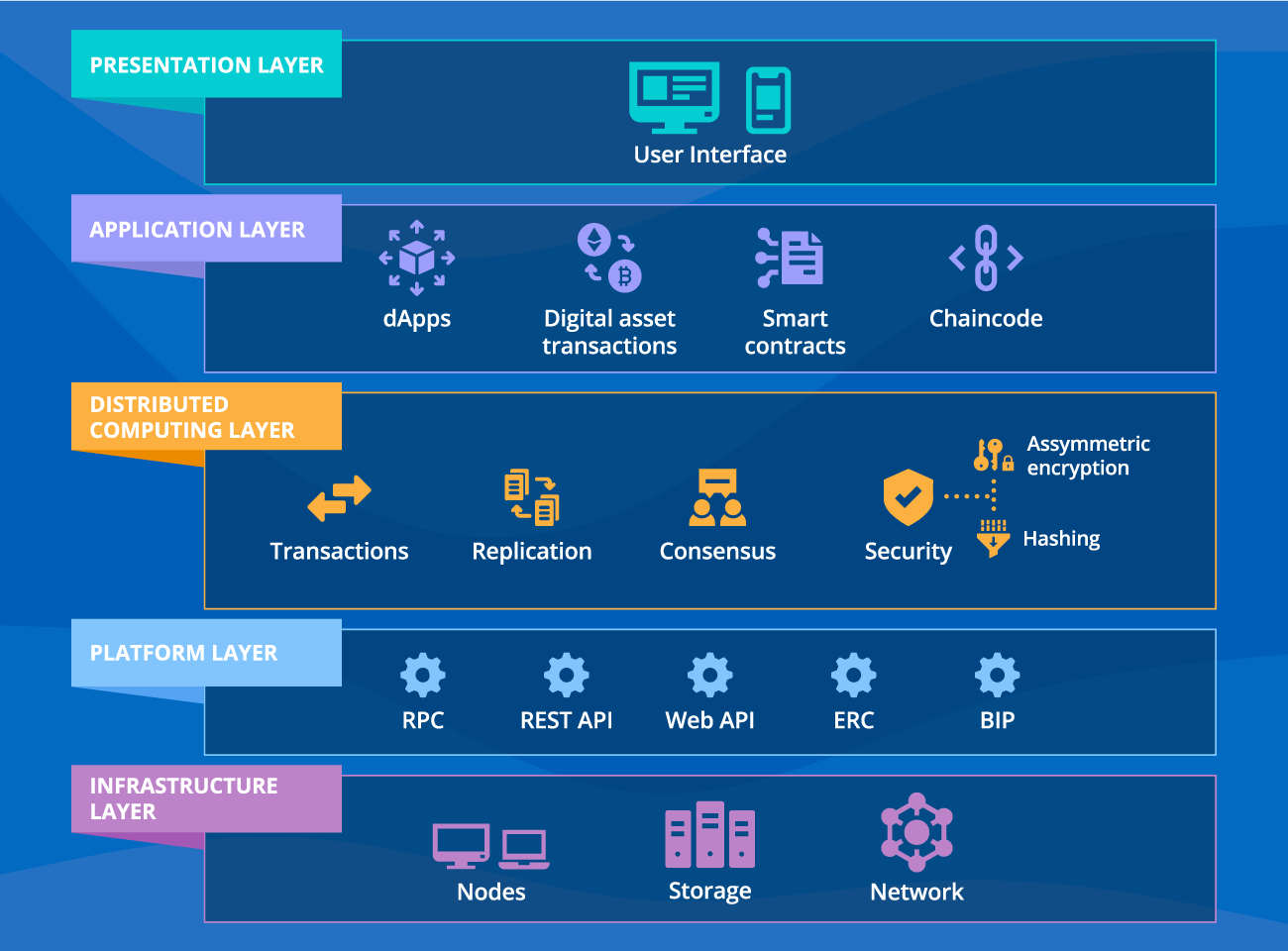Blockchain Implementation
A Comprehensive Guide
ScienceSoft applies 36 years of experience in IT and 6 years in blockchain development to help companies from 30+ industries design and implement reliable blockchain solutions.
Blockchain Implementation: Summary
Blockchain implementation is aimed to help companies leverage innovative solutions that introduce blockchain-based data storage and processing. Blockchain technology promotes data immutability and integrity and offers safe and effective workflow automation.
Blockchain software ensures full transparency, top-flight security, and fast processing of data and transactions. ScienceSoft's real-life project examples highlight the diverse applications of blockchain technology, illustrating its potential to transform various industries.
Key steps to implement blockchain technology:
- Conduct a feasibility study.
- Create a business case.
- Conceptualize the blockchain.
- Scope the project.
- Develop a Proof of Concept (optional).
- Design the blockchain solution.
- Select the tech stack.
- Develop and deploy the solution.
- Integrate it with existing systems.
- Provide after-launch support.
- Continuously evolve the solution.
Team: a project manager, a business analyst, a blockchain architect, a blockchain developer, a UX/UI designer, a front-end developer, a back-end developer, a DevOps engineer, a QA engineer.
Timelines: 4–12+ months, depending on the solution complexity.
Cost: Depending on the chosen approach to blockchain network implementation and other factors. Use our free calculator to estimate cost for your case.
Average payback period: 12–18 months for a custom blockchain.
As one of the top blockchain development companies, ScienceSoft can cover the end-to-end implementation of all required blockchain components – from infrastructure to consensus to business logic to user-facing apps. We ensure prompt rollout and excellent quality of blockchain solutions due to the proven tech skills and multi-industry expertise of our blockchain teams.
Innovative Blockchain Solutions for Various Use Cases
Visit ScienceSoft's dedicated pages to learn about the capabilities, benefits, and costs of niche blockchain-enabled solutions:
Blockchain networks
Secure and scalable permission-based or permissionless decentralized ecosystems with minimized downtime.
Blockchain-based transaction platforms
Peer-to-peer platforms with no single point of failure for transparent, fast, and safe multi-party transactions.
Blockchain-based assets
Programmable crypto assets built on blockchain that may represent a digital form of money, tradeable assets, utilities, governance rights, and more.
Blockchain's Major Architectural Components
Here at ScienceSoft, we rely on a flexible multi-layered blockchain architecture and help our clients implement any components required for the seamless functioning of their blockchain solutions.

Network
Physical and logical infrastructure serving to connect blockchain nodes, enable communication between them, and propagate transactions and blocks.
Nodes
Individual devices storing a copy of a shared blockchain ledger and validating transactions according to the network’s consensus algorithm.
Storage
On-chain and off-chain storage systems used to store the blockchain ledger with transaction records (including metadata) and smart contract code.
A protocol ensuring all nodes agree on the validity of transactions and the sequence in which they are added to the blockchain.
Security
Hashing and asymmetric encryption mechanisms ensuring the integrity of data stored in the blockchain and safe blockchain transactions.
Integration solutions
APIs, cross-chain bridges, and interoperability protocols enabling communication between blockchain solutions and external systems.
Logic
Self-executing agreements with predefined rules (smart contracts, chaincode) serving to automate blockchain transactions when certain conditions are met.
Tokens
Blockchain-based assets representing a means of payment, ownership of digital or physical assets, utility, governance rights, and other forms of value.
User interfaces
The front-end component (web, mobile, and desktop interfaces) enabling blockchain participants and authorized third parties to interact with the network.
Approaches to Blockchain Network Implementation
A blockchain network is the backbone of any blockchain solution. There are two main approaches to launching a blockchain network, each having its benefits and limitations. The choice of a particular approach depends on each company’s specific needs and requirements for the blockchain project implementation cost and timelines.
Building a custom blockchain from scratch
Best for: Blockchain startups and fintech companies that want to come up with a unique product or service.
A blockchain network is designed and developed from scratch. Other architecture components are then built on it to get a required blockchain solution.
Benefits: The ability to implement a blockchain solution fully tailored to your business needs.
Cautions: Custom design and development require much time and high investments.
Forking an existing blockchain protocol and creating a new blockchain
Best for: Companies seeking to implement blockchain for corporate use.
A blockchain network is designed based on the open-source code of a well-established blockchain protocol (e.g., Ethereum, Hyperledger Fabric). The code is modified according to your requirements to introduce a new blockchain network with different features and rules to operate independently and host your blockchain apps.
Benefits: Significantly reduced cost of blockchain development and 1.5-2x faster blockchain launch, compared to a custom approach.
Cautions: The risk of choosing an inappropriate blockchain protocol to fork.
NB! Suppose you’re looking to implement a standalone decentralized application or a crypto asset rather than a fully functional blockchain. In this case, you may consider developing and deploying them on an open-source blockchain platform (e.g., Ethereum, Tezos, EOS). This option enables a fast and cost-effective launch of the required app or asset. However, the underlying blockchain architecture, consensus mechanism, and recordkeeping rules cannot be customized to your needs.
How to Implement Blockchain Technology
The duration and approach to the blockchain solution design and implementation depend on the specifics and scale of operations the solution should cover. Below are described typical steps we at ScienceSoft take to implement a blockchain.
Step 1.
A feasibility study
Although general and use-case-specific benefits of blockchain look persuasive, blockchain viability requires assessment for each business situation. ScienceSoft’s consultants help analyze the economic feasibility of blockchain technology implementation. We work in close collaboration with project stakeholders to get an in-depth understanding of the company’s needs and introduce a list of tangible benefits that blockchain technology can bring. We also deliver a high-level cost breakdown and calculate ROI for implementing blockchain technology.
Step 2.
Building a business case
To create a reliable framework for planning and managing your blockchain initiative, we do the following:
- Elicit and document functional and non-functional requirements for the blockchain solution.
- Identify and resolve conflicting requirements.
- Analyze potential risks, including related to regulatory compliance (e.g., with AML/CFT and KYC, SEC, FINRA, GDPR, ISO 27001/27002, HIPAA, etc.).
Step 3.
Blockchain network conceptualization
This stage involves decision-making on:
- A proper blockchain network type (private, public, or hybrid).
- A best-fitting consensus mechanism (e.g., Proof of Stake, Proof of Authority).
- An optimal approach to implementing a blockchain network (building a blockchain from scratch or forking an existing blockchain protocol).
If your company opts for the forking approach, ScienceSoft can conduct a comparative analysis of the market-available blockchain protocols to help you choose the one that meets your blockchain needs best and requires the least modification efforts.
Step 4.
Project scoping
During this stage, ScienceSoft defines:
- Objectives, milestones, and KPIs for the project.
- Project deliverables and the scope of tasks to perform.
- Project duration, schedule, and a time-framed budget.
- Project-associated risks and the ways to mitigate them.
Step 5.
Proof of concept development
Optional.
We recommend opting for a PoC and/or blockchain prototypes in case you need to check the viability of an innovative blockchain solution or test the blockchain potential to meet your specific business and technical expectations.
Step 6.
Blockchain solution design
- Feature road-mapping
- Preparing a detailed feature list for the blockchain solution, including cybersecurity features.
- Feature prioritization based on the cost-benefit analysis.
- Architecture design. Designing a secure, scalable, high-performing architecture for the blockchain solution components and their interactions.
- Integrations planning
- Suggesting cross-chain interoperability patterns for the blockchain solution.
- Preparing an integration plan with the required systems (e.g., accounting software, an ecommerce portal, an SCM solution, crypto wallets, etc.).
- UX and UI design
Step 7.
Tech stack selection
At this stage, ScienceSoft assists in:
- Defining techs and tools required for the blockchain solution implementation.
- Comparing different techs and tools in the context of documented business requirements.
- Selecting the optimal techs and tools.
When forming a tech stack for blockchain implementation, we at ScienceSoft always consider our clients’ priorities (minimized cost/time/risks of the solution implementation, etc.). To optimize project time and costs, we rely on ready-made components (smart contract building blocks, prebuilt UI components, open-source APIs, OOTB deployment scripts, etc.) where possible.
Step 8.
Blockchain development
The development of a blockchain-based solution with ScienceSoft usually has the following stages:
- Depending on the chosen approach to blockchain implementation:
- Developing a blockchain network from scratch.
- Modifying the code of an existing blockchain protocol (e.g., Ethereum, EOSIO, Solana, Polygon, Bitcoin) to build a new blockchain network.
- Smart contracts development to introduce business process automation.
- Developing on-chain and off-chain oracles to enable data exchange between smart contracts and external data sources.
- Developing user-facing applications (web, mobile, desktop) to interact with the blockchain solution.
- Developing the back end of the blockchain solution, including APIs and cross-chain interoperability protocols, to enable data aggregation, processing, and storage.
- QA activities in parallel with development.
Step 9.
Blockchain solution deployment
ScienceSoft’s team configures CI/CD pipelines to automate blockchain testing, integration, and release, sets up the solution’s infrastructure, backup and recovery procedures, and deploys the ready-to-use software to the production environment.
An enterprise blockchain should be first deployed to one of the target user groups or facilities for a pilot run. This way, you’ll be able to handle possible issues and change requests before rolling out the solution enterprise-wide and avoid costly adjustments.
Step 10.
Integration with other systems (if required)
At this stage, ScienceSoft’s team implements and tests integrations with the required systems, including those built on other blockchains, to enhance the solution’s value for end users.
Step 11.
Support and evolution
ScienceSoft offers a range of services to ensure the smooth operation of the blockchain solution in the long run. Particularly, our team can monitor blockchain performance, handle operational issues, and modify or add functionality following the changes in business and end user needs.
Although blockchain provides advanced data security, it can be susceptible to certain types of cyberthreats, such as routing attacks, phishing attacks, and code exploitation. I recommend our clients to implement additional cybersecurity mechanisms (e.g., intelligent fraud detection algorithms, authorization controls for APIs) to ensure the protection of the blockchain solution and the data it stores, and perform regular network vulnerability scanning.
Consider Professional Services for Blockchain Implementation
In custom software design and engineering since 1989, ScienceSoft can provide established businesses and startups with:
- Analyzing your business needs and eliciting requirements for a blockchain solution.
- PoC development (optional).
- Introducing an optimal feature set, architecture design, and a tech stack for the blockchain solution.
- Suggesting the optimal integrations with external systems.
- Blockchain security and compliance consulting.
- A detailed plan for the implementation of blockchain technology, including a risk mitigation plan.
End-to-end blockchain implementation
- Blockchain conceptualization.
- Blockchain solution development.
- Developing APIs and cross-chain interoperability protocols.
- Integrating the solution with the required systems.
- Quality assurance of the blockchain solution.
- Drawing up user training materials and conducting user training (optional).
- Support and evolution of the blockchain solution (if required).
Why Choose Blockchain Implementation with ScienceSoft
- Since 2020 in enterprise blockchain development and cryptotech.
- 350+ seasoned software developers, 50% of whom are seniors or leads with 9–20 years of experience.
- Experience with Ethereum, Hyperledger Fabric, Graphene, and other leading blockchain frameworks.
- Since 2003 in cybersecurity to ensure world-class protection of blockchain solutions.
- Software development expertise in 30+ industries, including retail, manufacturing, healthcare, telecoms, BFSI.
- Quality-first approach based on a mature ISO 9001-certified quality management system.
- ISO 27001-certified security management based on comprehensive policies and processes, advanced security technology, and skilled professionals.
Our awards, certifications, and partnerships
Typical Roles on ScienceSoft’s Blockchain Development Teams
Project Manager
Plans the blockchain implementation project (goals, timeline, budget), prioritizes the scope of work and monitors its execution, coordinates the project team’s work, communicates with stakeholders, and reports to them.
Business Analyst
Elicits and documents functional and non-functional requirements for the blockchain solution, defines technical limitations, features, and integrations with other systems.
Blockchain Architect
Designs the architecture of the blockchain solution with integration points for its components and required systems, including those built on other blockchains.
Blockchain Developer
Delivers the code of the blockchain, including smart contracts code, integrates the solution components with each other and with other systems, and fixes code issues found by the QA team.
UX/UI Designer
Designs the user experience and user interface of user-facing applications.
Front-end Developer
Delivers UI of user-facing apps and fixes code issues found by the QA team.
Back-end Developer
Delivers the code of the back end of user-facing apps and fixes code issues found by the QA team.
DevOps Engineer
Containerizes blockchain components, configures CI/CD pipelines for streamlined testing and facilitated deployment.
Quality Assurance Engineer
Designs and implements a test strategy, a test plan, and test cases to validate the quality and security of the blockchain solution.
Sourcing Models for Blockchain Implementation
Benefits of Blockchain Implementation with ScienceSoft
|
|
Fast development
|
|
|
Optimized costs
|
|
|
Flexible pricing options
|
ScienceSoft’s Tech Stack for Blockchain Implementation
To deliver reliable blockchain solutions, ScienceSoft relies on a range of mature technologies, including:
Cost of Blockchain Implementation
Below, our consultants list major factors that affect the cost and duration of blockchain implementation:
- The chosen approach to blockchain implementation (development from scratch or forking).
- A blockchain network type – private, consortium, or hybrid.
- The required consensus mechanism (e.g., PoS, PoA, Byzantine Fault Tolerance).
- (in case of forking) The chosen blockchain protocol to fork, which defines a blockchain transaction cost.
- The number and complexity of a solution’s functional modules.
- The number and complexity of web and/or mobile applications for various user groups to interact with the blockchain.
- The number and complexity of potential integrations with relevant software, which influences integration API development.
- Blockchain solution performance, scalability, cross-chain interoperability, and security requirements.
- The required deliverable (a PoC, an MVP, a full-scale solution).

From ScienceSoft's experience, the cost of implementing blockchain software may vary from $50,000 to $2,000,000+, depending on solution complexity (a basic dApp, a decentralized platform, a large-scale network comprising role-specific apps and smart contracts, etc.).
Want to understand the cost of your blockchain project?
Learn the Cost of Your Blockchain Solution
Answer a few questions about your business needs to help our consultants estimate the cost of your unique blockchain software quicker.
Thank you for your request!
We will analyze your case and get back to you within a business day to share a ballpark estimate.
In the meantime, would you like to learn more about ScienceSoft?
- Project success no matter what: learn how we make good on our mission.
- 4,200+ successful projects: explore our portfolio.
- 1,400+ incredible clients: read what they say.

About ScienceSoft
ScienceSoft is an global IT consulting and software development company headquartered in McKinney, Texas. We provide consultancy and development services to help our clients implement robust blockchain solutions. In our projects, we employ robust quality management and data security management systems backed up by ISO 9001 and ISO 27001 certificates.












